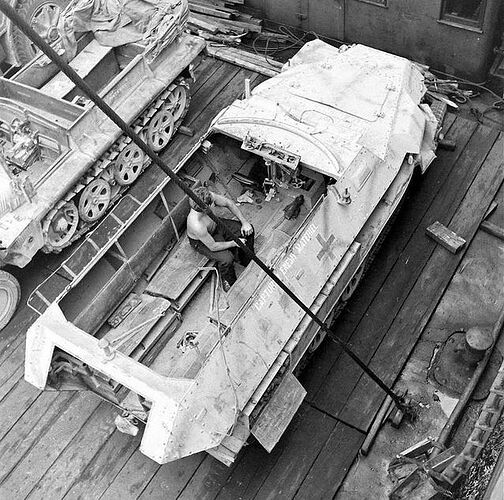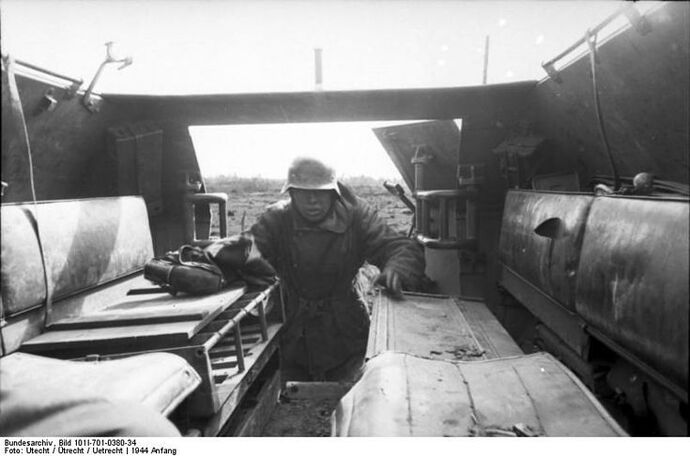I seem to remember reading somewhere that German open top vehicles (in this case Sd Kfz 251s) , the fighting compartment was painted the same as the exterior and driver’s area was elfenbein. Later the whole interior was the exterior color (by this time dunkelgelb. 'Course now I can’t find the reference.  Yes? No? Maybe? And, if so, what time frame?
Yes? No? Maybe? And, if so, what time frame?
As far as I know, only 251 Ausf. A got the driver area in elfenbein.
All that had Dunkelgelb exterior got it inside as well
Dunkelgelb came in Feb 43. Ausf Cs were made in 42. Ausf D started production in 43 but not sure when (Maybe varied by maker?) Wouldnt the Cs be elfenbein too.
Least the ones made afore the paint switch
As said, As far as I know, only 251 Ausf. A got the driver area in elfenbein.
First one is interesting … post war on it’s way to the US? Says captured and the fitting on the right looks rather ship like. Looks like an Ausf C. Was there an overlap between C and D prodution? Or, if an early vehicle was repainted would the drivers area have been repainted too. Looks like Last one, from the uniforms, looks early on but the paint job doesnt look like dunkelgrau.
Stumbled into an article from another build an his info was Ausf A/B = Elfenbein. C= Dunkelgrau, D=Dunkelgelb.
I have to ask. What color is “Elfenbein”?
Ivory… a light cream color off white
William ~ thank you for asking.
. . . . . And Stik ~ Thank you for answering
I did not know that!
Elfenbein morfed into cream weiss if i remember correctly.
Just to muddy the waters even more, perhaps the captured Ausf C came from North Africa and is in desert camouflage? That certainly seems the case with the Sdkfz 10 next to it.
I found this link about Sdkfz. 251/open-topped vehicles’ interior colors. It states that they began with the inside and out being the same color, but the driver’s area was in Elfenbein. However, when the Luftwaffe began losing air superiority, they began not using the Elfenbein due to it being easy to spot from the air. When they began using Dunkelgelb, they put that on the interior.
Additionally, on the Sdkfz. 251/8, the one with the canvas roof, would they have changed the inside colors, or would they ahve kept the Panzergrau/Dunkelgelb?
Is Dunkelgrau dark gray? What does it look like compared to Panzergrau?
The Luftwaffe really did not lose battlefield air superiority until early 1944, well after the change over to the Dunkelgelb base color. In 1943, Allied ground troops in the Mediterranean theater and Eastern Front were regularly subjected to Luftwaffe ground attack. Each side could achieve temporary local battlefield air superiority for most of 1943 by concentrating their air assets. But the Allies were building a numerical edge as the year went on.
Most likely the reason was one of cost cutting or speeding up production time by removing the use of the Elfenbein in the driver compartment. It’s quicker and easier to paint one color than two, as well as reducing the number colors of paints required to be kept on hand at the production line.
That makes sense. At what point did the wehrmacht not paint the inside of closed vehicles like tanks?
Dunkelgrau IS “Panzergrau”. RAL7021. Panzergrau is something model paint makers made up. 7021 is very dark … almost blusish black. Pre war- till after Poland was used with a very dark brown. (hard to see in photos due to lack of contrast… Same as RAL8000/ 7008. Between lack of contrast and dust looks like a single color. AND feldgrau (field grey) is not a vehicle color … unless the vehicle is wool. Closed vehicles were elfenbein (mostly) to help reflect light inside. Inside of hatches usually painted the exterior color… so when opened you didnt have a big white patch in the middle of your camo saying “aim here!”. German Armor Camouflage (panzerworld.com)
o
So the gray german vehicles are just a dark gray then?
What type vehicle? Inside? Outside? What time frame?
World War II German AFV Camouflage Painting Datasheet and Timeline
- December 1, 1927 – Nr. 17 Erdgelb-matt, Nr. 28 Gruen-matt, Nr. 18 Braun-matt.
- November 7, 1938 – Nr. 46 Dunkelgrau covering 2/3, Nr. 45 Dunkelbraun covering 1/3.
- July 31, 1940 – Dunkelgrau RAL 7021.
- February 18, 1943 – Dunkelgelb RAL 7028 basecoat, Olivgrun RAL 6003, Rotbraun RAL 8017.
- August 19, 1944 – Dunkelgelb RAL 7028 basecoat, Olivgrun RAL 6003, Rotbraun RAL 8017 in Hinterhalt – Tarnung (the “Ambush” scheme).
- September 31, 1944 – Rotoxid primer, “sparingly applied patches” of Dunkelgelb RAL 7028, Olivgrun RAL 6003, Rotbraun RAL 8017. [NO Rotoxid primer showing.]
- November 20, 1944 – Olivgrun RAL 6003 basecoat, Dunkelgelb RAL 7028, Rotbraun RAL 8017 “in sharp contours”. (To go into full effect June 1, 1945).
Tropen Pattern
- March 17, 1941 – Grunbraun RAL 8000 covering 2/3, Graugrun RAL 7008 covering 1/3.
- March 25, 1942 – Gelbbraun RAL 8020 covering 2/3, Sandgrau RAL 7027 covering 1/3.
Dates are Inspektorate 2 order dates.
RAL Farbtonkarte of June 1932 and RAL Farbtonkarte of February 10, 1941.
Note that RAL Farbtonkarte was revised in 1953 and 1961. Current RAL numbers, colors and titles DO NOT match World War II Numbers, colors and titles.


